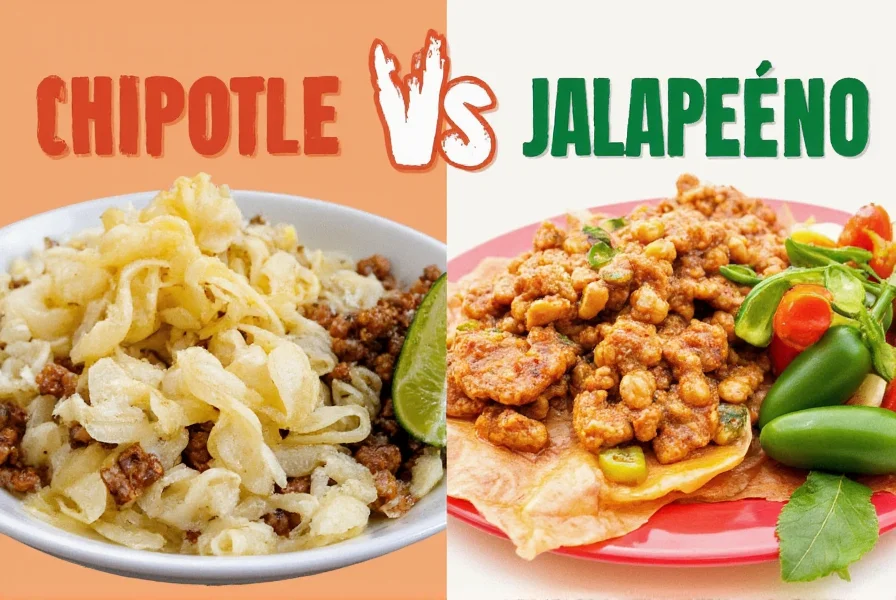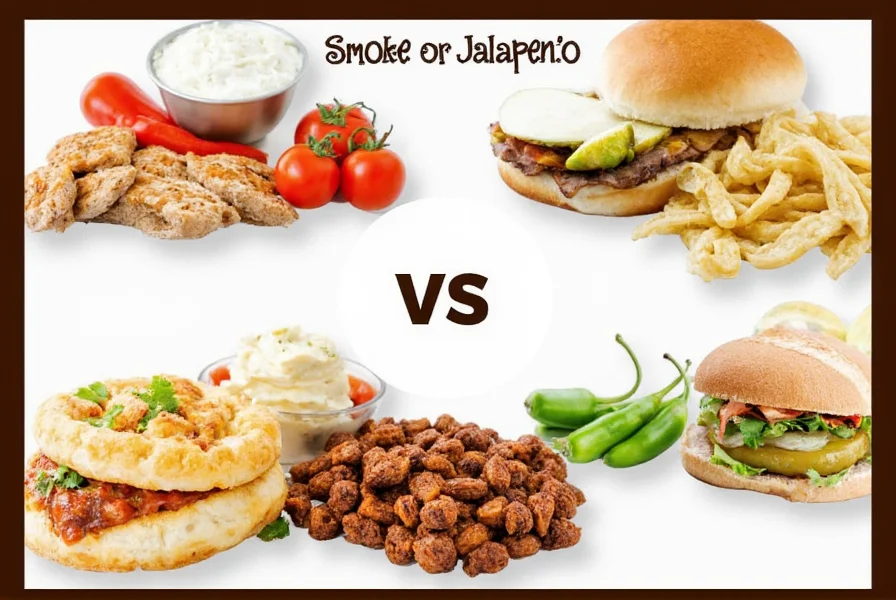Smoky or Spicy? A Humorous Face-Off: Chipotle vs Jalapeño Recipes That’ll Blow Your Mind!
Table of Contents
- Introduction: Meet the Heat
- Chipotle Peppers: Smoked to Perfection
- Jalapeños: The Party Starter Pepper
- Chipotle vs Jalapeño: Battle of the Flavors
- 5 Smokin’ Recipes You Can Make with These Fiery Gems
- Buying Guide: Picking the Perfect Pepper (Fresh, Dried, or in Adobo?)
- Storage Tips: Don’t Let the Flavor Fade Away
- Conclusion: Spice Up Your Life With Confidence
Introduction: Meet the Heat
If you’ve ever stared into your pantry wondering whether to reach for that jar of smoky chipotle peppers or those bright green jalapeños, then this post is your spicy salvation. Today, we’re diving deep into the world of chili chipotle peppers and jalapenos recipe options — not just what they are, but how to use them, when to use them, and why sometimes a little smoke goes further than a sharp sting.
Chipotle Peppers: Smoked to Perfection
The chipotle pepper is basically a jalapeño who went to culinary school and came back with a smoking jacket — literally. Once jalapeños ripen to red, they're smoked and dried, turning them into these wrinkled flavor bombs packed with heat and depth.
Flavor Profile:
- Heat Level: Medium-hot (around 2,500–8,000 Scoville units)
- Flavor Notes: Smoky, earthy, slightly sweet
- Common Forms: Dried whole, ground into powder, or canned in adobo sauce
Canned chipotles in adobo are like the MVPs of the spice world — ready to add serious flavor with zero effort. One spoonful can transform sauces, soups, or even desserts (yes, really).
Jalapeños: The Party Starter Pepper
Jalapeños are the life of the kitchen party. Fresh from the garden or straight from the fridge, these guys bring zesty brightness and a bit of kick without scaring off the spice-shy crowd.
Flavor Profile:
- Heat Level: Mild to medium (2,500–5,000 Scoville units)
- Flavor Notes: Grassier, vegetal, crisp bite
- Common Uses: Raw in salsas, pickled, grilled, or stuffed
Jalapeños thrive in freshness — slicing them into guacamole or throwing them into nachos gives a crunchy contrast. If you want more heat, leave the seeds; if you prefer milder notes, scoop ’em out like you’re performing surgery on a pepper.
Chipotle vs Jalapeño: Battle of the Flavors
To make things clearer, here’s a visual showdown between these two heavyweights:
| Feature | Chipotle Pepper | Jalapeño Pepper |
|---|---|---|
| Origin | Smoke-dried ripe jalapeño | Fresh green or red jalapeño |
| Heat Level | Mild to Hot (depending on usage) | Mild to Medium |
| Flavor | Smoky, deep, earthy | Grassy, fresh, zesty |
| Best Use | Slow-cooked dishes, marinades, BBQ sauces | Salsas, tacos, appetizers |
| Form Available | Dried, powdered, canned in adobo | Fresh, pickled, canned |
5 Smokin’ Recipes You Can Make with These Fiery Gems
Now that we know our contenders, let’s put them to work! Here are five recipes that show off both peppers in their prime forms — and yes, some recipes combine both for maximum flavor fireworks.
1. Chipotle BBQ Chicken Skewers
Why it works: The smoky edge of chipotles elevates grilled chicken skewers with a sticky glaze that caramelizes beautifully over open flame.
- Ingredients:
- Chicken breast cubes
- Chipotle in adobo (blended into a paste)
- Honey
- Lime juice
- Olive oil
- Skewer sticks
Tips: Soak wooden skewers overnight to avoid burning. Serve with a mango-cucumber slaw for a refreshing balance.
2. Classic Jalapeño Poppers
Why it works: Crispy bacon-wrapped jalapeños filled with creamy cheese — because sometimes spice needs a little fat to balance it out.
- Halved jalapeños
- Cream cheese (or goat cheese for tanginess)
- Bacon strips
- Panko breadcrumbs
- Optional: cheddar cheese sprinkle
Tips: For extra flavor, top with a drizzle of honey before serving — sweet + salty + spicy = bliss.
3. Chipotle-Jalapeño Salsa
Why it works: Combine both peppers for a layered flavor experience — smoky base meets bright heat.
- Roasted tomatoes
- One chipotle in adobo (plus a splash of sauce)
- 1–2 jalapeños (seeds removed)
- Garlic clove
- Lime juice
- Cilantro
Tips: Blend everything together until chunky, then chill for 30 minutes for deeper flavor infusion.

4. Jalapeño Honey Butter Steak Bites
Why it works: Sweet meets spicy in a fast weeknight dish that’s restaurant-worthy without breaking a sweat.
- Beef sirloin chunks
- Butter
- Honey
- Jalapeño slices (seeded for mildness)
- Soy sauce
- Garlic powder
Tips: Cook steak to medium-rare for juiciest results. Spoon over rice or wrap in warm tortillas for quick eats.
5. Chipotle Mac & Cheese
Why it works: Because macaroni and cheese deserves a grown-up upgrade — especially one with a subtle fire undertone.
- Elbow macaroni
- Sharp cheddar
- Whole milk
- Butter
- Flour
- 1–2 tsp chipotle powder or minced chipotle in adobo
- Breadcrumbs
Tips: Bake with a golden topping for crunch. Add crumbled bacon for smoky-salty-spicy magic.
Buying Guide: Picking the Perfect Pepper
Choosing between chipotle and jalapeño isn't just about flavor — it's also about form, freshness, and function. Here’s how to select the best for your needs.
For Chipotles
- In Adobo Sauce: Look for jars with a thick, reddish sauce and soft, pliable peppers. Brands like La Costeña and Don Julio offer reliable quality. Ideal for sauces, stews, and marinades.
- Dried Whole: Wrinkled and dark brown, dried chipotles should be flexible, not brittle. Great for grinding into powder or soaking for rehydration.
- Powder: Use sparingly — a little goes a long way. Opt for pure chipotle powder (not mixed with other spices) for authentic flavor.
For Jalapeños
- Fresh: Firm, glossy, and unblemished. Avoid soft or wrinkled ones. Bright green is classic, but red jalapeños pack more sweetness and heat.
- Pickled: Sold in jars or cans, these are perfect for garnishing tacos, sandwiches, or salads. They keep well and offer a tangy kick.
- Canned: Milder and softer in texture, canned jalapeños are good for baking or adding subtle spice to casseroles.
Use Cases Comparison
| Pepper Type | Best For | Not Recommended For |
|---|---|---|
| Chipotle in Adobo | Sauces, braises, burgers | Raw applications |
| Dried Chipotle | Moist cooking methods (soups, stews), rubs | Salads, cold dishes |
| Chipotle Powder | Seasoning blends, dry rubs, sprinkling | Substituting for fresh peppers |
| Fresh Jalapeños | Salsas, garnishes, light grilling | Long-cooking dishes |
| Pickled Jalapeños | Garnishes, charcuterie, tacos | Cooking from scratch |
Storage Tips: Don’t Let the Flavor Fade Away
Proper storage ensures your spicy stars stay fresh and flavorful longer:
- Fresh Jalapeños: Store in the fridge in a breathable bag for up to two weeks. Freeze whole or sliced for future use.
- Pickled Jalapeños: Once opened, keep refrigerated and consume within six months.
- Chipotle in Adobo: Refrigerate after opening and use within three weeks. Alternatively, freeze leftover peppers in ice cube trays with sauce for easy portioning.
- Dried Chipotle: Keep in an airtight container away from light and moisture. Lasts up to a year.
- Chipotle Powder: Store in a cool, dark place. It doesn’t spoil, but flavor diminishes over time (about six months).
Conclusion: Spice Up Your Life With Confidence
Whether you lean toward the sultry smokiness of chipotles or the snappy freshness of jalapeños, knowing how to use each will elevate your cooking game. From bold barbecues to zesty salsas, these peppers aren’t just ingredients — they’re flavor superheroes in disguise.
So next time you’re standing at the crossroads of spice, ask yourself: Do I want a whisper of wood-fired drama, or a punchy burst of garden-fresh heat?
Whichever you choose — welcome to flavor town. Pack a napkin, it might get messy.











 浙公网安备
33010002000092号
浙公网安备
33010002000092号 浙B2-20120091-4
浙B2-20120091-4